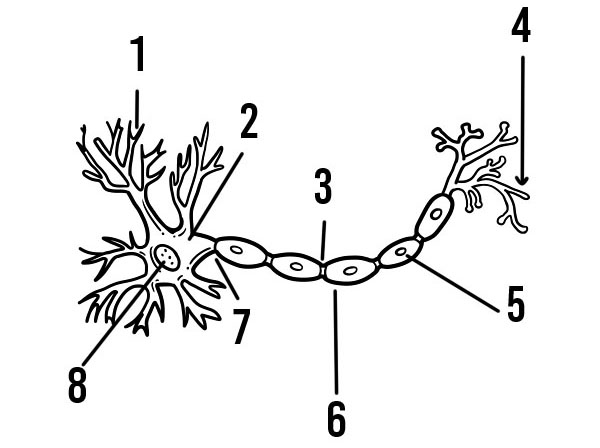Neurons are also known as nerve cells. Nearly 86 billion nerve cells work together within the nervous system to communicate with the rest of the body.
In this lesson, you’ll learn about
Neurons are the specialized cells that transmit chemical and electrical signals in the brain; they are the basic building blocks of the central nervous system. They send and receive signals with allow us to move our muscles, feel our surroundings, remember things and much more.
A neuron has four main parts:
A single neuron may have thousands of dendrites, so it can communicate with thousands of other cells but only one axon.
Myelin sheath
The axon is covered with a myelin sheath, a fatty layer that insulates the axon and allows the electrical signal to travel much more quickly. The Node of Ranvier is any gap within the myelin sheath exposing the neuron, and it allows even faster transmission of a signal.
Glial cells
Myelin is produced by glial cells which are non-neuronal cells that provide support for the nervous system. Glia function to hold neurons in place, supply them with nutrients, provide insulation, and remove pathogens and dead neurons. In the central nervous system, the glial cells that form the myelin sheath are called oligodendrocytes; in the peripheral nervous system, they are called Schwann cells.

Based on their roles, the neurons can be divided into three classes:
Interneurons are the most numerous class of neurons and are involved in processing information, both in simple reflex circuits and in more complex circuits in the brain.
When a stimulus is received by a sensory neuron, the impulse is carried through dendrites to the cell body. The impulse travels through the cell body and is carried through the axon to the end brush, a collection of fibers that extend off the axon. Here, the impulse triggers a release of chemicals that allow the impulse to travel through the synapse. An impulse travels along the neuron pathways as electrical charges move across each neural cell membrane. Ions moving across the membrane cause the impulse to move along the nerve cells.
The difference in the number of positively and negatively charged ions causes electrical charge on each side of the cell membrane – this produces a resting potential. Neurons have a resting potential of approximately 70 millivolts (mV).
Specifically, the cell membrane proteins pump sodium ions (Na+) out of the neuron and pump potassium ions (K+) into the neuron. This movement of both the Na+ and K+ ions produces a negative charge on the inside of the neuron’s cell membrane.
When a neuron is stimulated by another neuron or by an environmental stimulus, an impulse begins. The cell membranes begin to change the flow of ions and a reversal of charges result in the ‘action potential’. An impulse that changes one neuron, changes the next. This is how the impulse moves along the pathway.